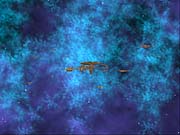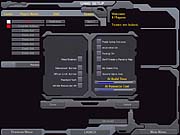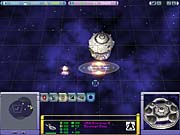Star Trek: Armada II Updated Preview
Star Trek: Armada II will add full 3D combat and other new features to the successful formula of its predecessor.

For 35 years, Star Trek hasn't merely been a string of hit shows and films, but a genuine cultural phenomenon. Even people who've never seen a Star Trek episode likely know who Mr. Spock is and could recognize the Enterprise in at least one of its incarnations. For all of Star Trek's success in reaching the general public, attempts to translate Gene Roddenberry's optimistic vision of the future into games have met with mixed results, to put it nicely. It's long been almost an article of faith among gamers to be wary of any game bearing the Star Trek name, thanks to more than a few duds. Over the past couple of years, though, games like Deep Space Nine: The Fallen, Star Trek: Voyager Elite Force, and Star Trek: Armada have shown that care and imagination can create some genuinely rewarding Star Trek gaming experiences. It looks like Star Trek: Armada II, Activision's upcoming real-time strategy game, might well continue that welcome trend.

The original Armada, released last year, let you engage in one of the most entertaining aspects of the Star Trek universe: battles among fleets of powerful starships. While a fairly traditional real-time strategy game at heart, Armada nevertheless made good use of its source material, letting the Federation and other major Trek powers fight for supremacy in visually exciting battles. Armada II opens with an explosive intro movie filled with brutal space combat, letting you know right away that the core focus is the same in the new game. At the same time, Armada II should build on the success of its predecessor with many new features, not the least of which is true 3D combat instead of the isometric viewpoint of the original. It bodes well that the game's developer, Mad Doc Software, includes members of the original Armada team, as well as former employees of the late, great Looking Glass Studios.
Armada II plays out in the Trek universe as found in the Next Generation, Deep Space Nine, and Voyager television series. This universe features an almost Byzantine back story, with massive wars, shifting alliances, and political intrigue. In three single-player campaigns totaling around 30 missions, Armada II will focus on three of the chief players in that saga: the United Federation of Planets, the militant Klingon Empire, and the nearly unstoppable Borg. As the game opens, tensions between the Klingons and Cardassians are on the rise, and the Borg have developed a new weapon capable of assimilating entire planets, as they demonstrate on a world near the edge of the Neutral Zone. So, it's time to set aside diplomacy and reach for the phaser controls. Unlike in the original Armada, the Romulans won't get their own campaign in Armada II, but they'll appear along with the ruthless Cardassians and Species 8472 as enemies in the single-player campaigns. All six major races found in the game will be available to you in full-featured skirmish and multiplayer modes.
Harvest, Build, Assimilate

Like its predecessor, Armada II sticks with many standard RTS conventions. To support your fleet operations and build ships, you'll need to harvest resources by building space-based mining stations and processing facilities near resource-rich moons, planets, and nebulae. From these you'll extract vital dilithium, latinum, and metal. To help avoid micromanagement, these facilities will send out freighters that know to head to the nearest appropriate resource on their own. In addition to raw materials, crewmembers will form a vital resource for running ships and acting as boarding parties. You'll gather new crewmembers from space stations and from planets you choose to colonize.
You can build trading stations that allow you to transfer resources to other players and generate latinum when Ferengi traders, smelling a profit, begin to arrive automatically. By sending cargo ships between your own stations, you can generate extra latinum, and the further apart those stations are, the more income you earn. That poses an interesting strategic challenge since the further you spread your stations out, the more likely they'll be open to enemy attack.

Where Armada II starts to differ significantly from many RTS games is in its combat. Rather reminiscent of the acclaimed Homeworld RTS games, the battles of Armada II play out in the full vastness of space with true 3D environments. Instead of your ships just moving and fighting on a single plane, they can move up and down on the Z axis, which of course opens up all kinds of tactical possibilities. You'll be able to switch between a standard top-down strategic view and a new 3D tactical view at will.
Naturally, fluid gameplay on three axes can create all kinds of interface and camera difficulties for a game, but it looks like Armada will handle the new features ably. To move on a horizontal plane or carry out other contextual orders like harvesting, you just right click on a destination or object. To move a ship up or down on the Z axis, you simply hold the shift key and drag the cursor to choose a new elevation and position. It seems like a pretty intuitive system. Visually keeping track of things looks fairly simple, too--you can pan the camera in any direction around any ship or object using multiple methods.
You'll put the new 3D system through its paces in the three campaigns and a full-featured and highly configurable skirmish mode. You can compete against up to seven computer-controlled players chosen from among the game's six races, and you can divide them into two to eight teams as you see fit. You can set the AI difficulty level for each competitor, choose from around 25 maps of different sizes, set the overall level of resources to be found, and so on. Full multiplayer support via a LAN or Internet connection will offer similar options. Multiplayer will likely offer variants of capture the flag, king of the hill, and cooperative play.
More of a Good Thing

The Star Trek universe is filled with memorable ship designs, from the sleek, birdlike Romulan vessels to the giant Borg cubes. In the eyes of some gamers, Armada, with its rather limited number of ships, didn't fully capture that diversity. Mad Doc plans to include around 100 different ship classes in Armada II, so you'll likely be able to find your favorites among them. An extensive technology tree will also help capture the breadth of the Star Trek universe by including things like galaxy-class ship separation, Vulcan research institutes, and temporal stasis fields. Unlike the original Armada, the sequel will also add diversity by ensuring that each race really plays significantly differently from the other. The Borg, for instance, will be able to assimilate other races' technology in two different ways.
Mad Doc is clearly working to implement the famous Star Trek look and feel in Armada II. Ships and stations are nicely detailed and should be easily recognizable to fans of the shows and films. Vivid visual effects, like ships seemingly stretching when they engage their warp drives, add to the ambience. Shields glow when hit with torpedoes, and repair ships emit roving beams of pulsating light as they aid their fellow vessels. Glowing nebulae and rotating planets and moons and help enliven what could otherwise be just dull expanses of inky space.
As RTS games like Starcraft have shown so well, unit command responses offer a great opportunity for the designers to add memorable character to a game. Armada II looks like it will delve into the Star Trek universe for plenty of appropriate and entertaining voice responses. You might hear Captain Picard say, "Make it so," or a Vulcan captain coolly remark, "That is a logical request."

You should be able to feel the unique Star Trek flavor in the game's interface, too. The clean menus and buttons feature the fonts and stylized control panel imagery found in the shows. Angular Klingon lettering, the star-filled Federation seal, and images of Borg cubes all add to the atmosphere. Mad Doc apparently knows that every little aspect of a game has the potential to add up to an entertaining whole--when you hold the cursor over a button on the main menu, it will display a little animated scene, like the Enterprise rushing past.
Armada II looks to be a user-friendly game. The gameplay is easily configured to suit your tastes--you can choose from four difficulty settings, set building time and cost handicaps for your computer opponent, and alter the game speed. To ease you into the game, a full-fledged tutorial offers six lessons. Optional pop-up tool tips help explain the in-game controls.
Armada II is building on one of the most popular Trek games to date by trying to recapture Armada's core RTS gameplay dynamic. At the same time, the new game is keeping up with the times by adding fully 3D combat and more-detailed resource and trading models. We should know this November if Armada II can do real justice to its famous Star Trek license.
Got a news tip or want to contact us directly? Email news@gamespot.com
Join the conversation